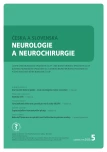Vlastnosti mikroflóry a rizikové faktory infekcí dolních cest dýchacích u pacientů se závažným kraniocerebrálním poraněním na jednotce intenzivní péče
Autoři:
M. Zhang; D. Zhi; J. Lin; P. Liu; Y. Wang; M. Duan
Působiště autorů:
Department of Critical Care Medicine, Beijing Friendship Hospital, Capital Medical University, Beijing, China
Vyšlo v časopise:
Cesk Slov Neurol N 2022; 85(5): 375-381
Kategorie:
Původní práce
doi:
https://doi.org/10.48095/cccsnn2022375
Souhrn
Cíl: Cílem této studie bylo prozkoumat vlastnosti mikroflóry a rizikové faktory infekcí dolních cest dýchacích u pacientů se závažným kraniocerebrálním poraněním na jednotce intenzivní péče. Soubor pacientů a metody: Byla shromážděna klinická data 457 vhodných pacientů hospitalizovaných od srpna 2015 do března 2020 a byly zaznamenány výskyt infekcí, distribuce patogenů a výsledky testů citlivosti na antimikrobiální léčiva. Byly analyzovány příslušné rizikové faktory. Výsledky: Z celkového počtu 457 mělo 150 pacientů infekce dolních cest dýchacích. Po kultivaci vzorků sputa bylo izolováno celkem 78 (52,00 %) kmenů grampozitivních bakterií, 65 (43,33 %) kmenů gramnegativních bakterií a 7 (4,67 %) kmenů kvasinek a plísní. Mezi nejčastějšími gramnegativními bakteriemi bylo zachyceno více multirezistentních nebo plně rezistentních kmenů. Grampozitivní bakterie vykazovaly 100% citlivost vůči vankomycinu and teikoplaninu a pouze Staphylococcus haemolyticus byl plně rezistentní vůči erythromycinu. Mezi nezávislé rizikové faktory patřily věk, doba trvání kómatu, tracheální intubace nebo incize, použití umělé plicní ventilace a podávání antibiotik (p < 0,05). Závěr: Nejčastější patogeny vyvolávající infekce dolních cest dýchacích u pacientů se závažným kraniocerebrálním poraněním na jednotce intenzivní péče vykazují rezistenci na široké spektrum antimikrobiálních léčiv a vysokou míru rezistence. Je nutné zajistit operace v aseptickém prostředí, striktně zabránit zkříženým infekcím a zlepšit imunitní funkce pacientů, čímž dojde ke zlepšení terapeutického účinku.
Klíčová slova:
rizikový faktor – jednotka intenzivní péče – závažné kraniocerebrální poranění – infekce dolních cest dýchacích – mikroflóra
Zdroje
1. Wunderink RG. POINT: Should inhaled antibiotic therapy be used routinely for the treatment of bacterial lower respiratory tract infections in the ICU setting? Yes. Chest 2017; 151 (4): 737–739. doi: 10.1016/j.chest.2016.11.006.
2. Liu H, Liu B, Zheng F et al. Distribution of pathogenic bacteria in lower respiratory tract infection in lung cancer patients after chemotherapy and analysis of integron resistance genes in respiratory tract isolates of uninfected patients. J Thorac Dis 2020; 12 (8): 4216–4223. doi: 10.21037/jtd-20-928.
3. Figueroa L, Laffaye F. Early use of continuous positive airway pressure in the treatment of moderate to severe acute lower respiratory tract infections among patients younger than 2 years old. Arch Argent Pediatr 2017; 115 (3): 277–281. doi: 10.5546/aap.2017.eng.277.
4. Woodhead M, Blasi F, Ewig S et al. Guidelines for the management of adult lower respiratory tract infections – full version. Clin Microbiol Infect 2011; 17 (Suppl 6): E1–59. doi: 10.1111/j.1469-0691.2011.03672.x.
5. Ministry of Health, P. R. China. National guide to clinical laboratory procedures. 4th Ed. Beijing, China: People’s Medical Publishing House 2015.
6. Jean SS, Lu MC, Ho MW et al. Non-susceptibilities to antibiotics against important Gram-negative bacteria, and imipenem-relebactam, meropenem-vaborbactam against carbapenem non-susceptible Enterobacterales and Pseudomonas aeruginosa isolates implicated in complicated intra-abdominal and urinary tract infections in Taiwan, 2019. Int J Antimicrob Agents 2022; 59 (3): 106521. doi: 10.1016/j.ijantimicag.2022.106 521.
7. Li CH, Huang LN, Zhang MC et al. Forensic psychiatric assessment for organic personality disorders after cranio-cerebral trauma. Fa Yi Xue Za Zhi 2017; 33 (2): 158–161. doi: 10.3969/j.issn.1004-5619.2017.02.010.
8. Huang Q, Xu H, Xiao QS. Clinical research of different analgesia methods on perianesthetic pain of patients with moderate and severe craniocerebral injury who have emergency operation. Eur Rev Med Pharmacol Sci 2017; 21 (3 Suppl): 88–92.
9. Tonacio AC, Oliveira MS, Malbouisson LM et al. Trauma is associated with a better prognosis in intensive care patients with Acinetobacter infections. Infection 2014; 42 (1): 89–95. doi: 10.1007/s15010-013-0523-y.
10. Shengchen D, Gu X, Fan G et al. Evaluation of a molecular point-of-care testing for viral and atypical pathogens on intravenous antibiotic duration in hospitalized adults with lower respiratory tract infection: a randomized clinical trial. Clin Microbiol Infect 2019; 25 (11): 1415–1421. doi: 10.1016/j.cmi.2019.06.012.
11. Nguenha N, Tivane A, Pale M et al. Clinical and epidemiological characterization of influenza virus infections in children with severe acute respiratory infection in Maputo, Mozambique: results from the implementation of sentinel surveillance, 2014–2016. PLoS One 2018; 13 (3): e0194138. doi: 10.1371/journal.pone.0194 138.
12. Fitzner J, Qasmieh S, Mounts AW et al. Revision of clinical case definitions: influenza-like illness and severe acute respiratory infection. Bull World Health Organ 2018; 96 (2): 122–128. doi: 10.2471/BLT.17.194 514.
13. Zhong B, Sun SL, Du JT et al. Risk factors for lower respiratory tract infection in children with tracheobronchial foreign body aspiration. Medicine (Baltimore) 2019; 98 (10): e14655. doi: 10.1097/MD.0000000000014 655.
14. Cao C, Zhang L. Nursing care of lower respiratory tract infection after abdominal surgery. Cell Biochem Biophys 2015; 72 (2): 495–496. doi: 10.1007/s12013-014-0493-4.
15. Maccioni L, Weber S, Elgizouli M et al. Obesity and risk of respiratory tract infections: results of an infection-diary based cohort study. BMC Public Health 2018; 18 (1): 271. doi: 10.1186/s12889-018-5172-8.
Štítky
Dětská neurologie Neurochirurgie NeurologieČlánek vyšel v časopise
Česká a slovenská neurologie a neurochirurgie

2022 Číslo 5
Nejčtenější v tomto čísle
- Onemocnění bederní páteře – nová neurologická nemoc z povolání
- Cenobamát
- Výsledky rekonstrukčních operací lícního nervu
- Karotický web
